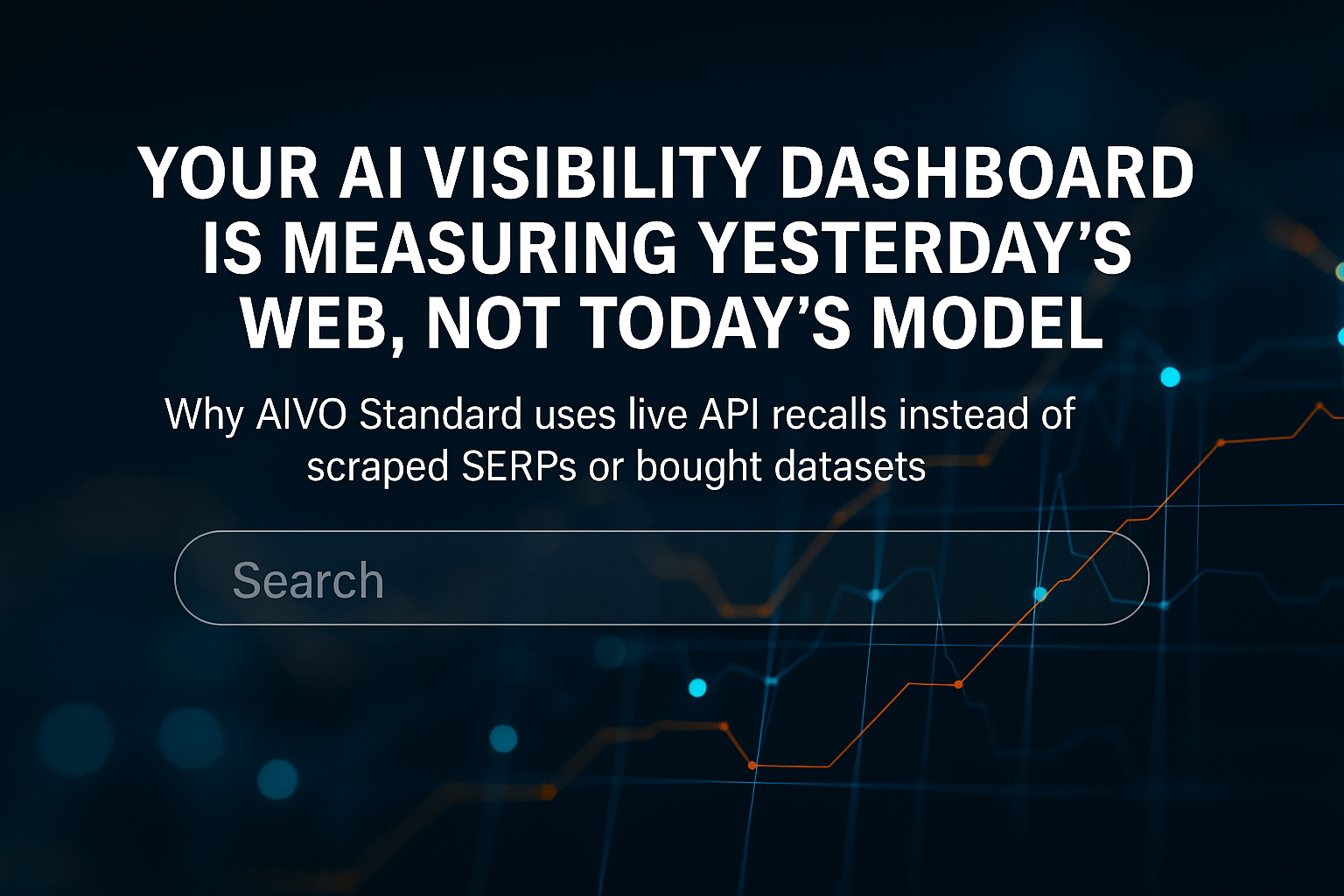Your AI Visibility Dashboard Is Measuring Yesterday’s Web, Not Today’s Model

Why AIVO Standard uses live API recalls instead of scraped SERPs or bought datasets
TL;DR:
Every major brand now tracks its “AI visibility.” Most are doing it wrong. If your dashboard builds on scraped or resold data, it’s describing a memory of the market—not the market itself. AIVO Standard measures live assistant behavior through authenticated API recalls, because visibility drift has become a measurable financial risk, not a technical curiosity.
1. The shift: from indexed web to living model
Generative engines don’t crawl; they reason.
Their “answers” depend on constantly updated retrieval layers, proprietary tools, and reinforcement cycles that never appear in search pages. Traditional GEO tools still scrape SERPs and call it visibility. The result: metrics that lag real user experience by days or weeks.
When ChatGPT, Gemini, or Claude retrain, brand presence can change overnight. By the time a crawler notices, millions in ad spend may have been optimized to a reality that no longer exists.
2. The risk: false precision costs money
Dashboards built on static datasets report clean, stable numbers—comforting but wrong.
AIVO’s live recall data show average visibility variance of 22–37 percent across model updates.
That volatility correlates with measurable conversion loss: a 0.1 drop in PSOS (Prompt-Space Occupancy Score) predicts 2–3 percent lower assisted conversions within 48 hours.
False precision is worse than noise. It directs budget toward invisibility.
3. Why live API recalls matter
Live recalls connect directly to official model interfaces under authenticated conditions.
Each run captures:
- Model identifier and version tag
- Full prompt–response pair
- Timestamps and locale
- Confidence metrics (CI, CV, ICC)
- Cryptographic hashes for replay
That audit trail allows AIVO to distinguish real market movement from data artefact.
Scraped datasets and reseller feeds cannot. They lack parameters, seeds, or provenance.
Without them, you cannot reproduce a result—so you cannot trust it.
4. Governance and compliance: the hidden fault line
Regulators and audit committees are starting to ask a simple question: “Where did this data come from?”
If your AI visibility reports are derived from scraped content, you can’t answer.
AIVO’s API-based method complies with vendor Terms of Service, maintains full chain of custody, and generates replayable logs suitable for SOX, ISO/IEC 42001, and AI-Act audits.
Boards no longer accept screenshots as evidence.
5. Operational consequence: volatility is the new insight
Visibility drift isn’t an error—it’s an early warning.
Live data reveals when a retrain, retrieval index swap, or moderation change hits your category.
Example: a consumer-beauty brand lost 18 percent of prompt recall within 36 hours of a Gemini update.
SERP-based dashboards didn’t register it for twelve days.
The missed window cost roughly $1.4 million in wasted spend before campaigns were recalibrated.
6. Hybrid claims don’t fix the problem
Many vendors now advertise “AI + SERP” hybrids: scraped pages blended with small samples of assistant output.
It sounds comprehensive; it isn’t.
Mixing surfaces collapses signal quality:
- Different ranking logics, no normalization
- Temporal smear hides change points
- No replay or parameter control
- Breaches of ToS disguised as “research access”
If it can’t be replayed, it can’t be audited. If it can’t be audited, it can’t inform budget.
7. Economic framing: what live data buys
|
Dimension |
Scraped
/ Resold |
Live API
Recalls (AIVO) |
|
Timeliness |
Days or weeks old |
Real-time, hourly cadence |
|
Reproducibility |
None |
±5 % tolerance, replayable |
|
Compliance |
Questionable |
Authenticated, ToS-aligned |
|
Governance readiness |
Unverifiable |
Audit-grade evidence |
|
Financial signal |
Lagging |
Predictive of revenue drift |
The premium for live data is minor compared with the cost of steering multimillion-dollar campaigns blind.
8. What to ask your current GEO vendor
- Are your results generated from authenticated API recalls?
- Can you reproduce any visibility report within ±5 % variance?
- Do you log full prompt chains and timestamps?
- Can you isolate volatility to a model update or index shift?
- Are your methods compliant with EU AI Act and vendor ToS?
If they hesitate, the numbers you are using to brief your CMO are marketing fiction.
9. What AIVO Standard delivers
- Live recall architecture across all major assistants (ChatGPT, Gemini, Claude, Perplexity)
- PSOS™ visibility scoring per prompt turn, volatility tracking, and drift attribution
- RaR™ (Revenue-at-Risk) analytics linking visibility loss to commercial impact
- Replayable audit logs and reproducibility certification for CFO and board reporting
Dashboards show snapshots. AIVO shows whether the movement is real—and fixes it when it isn’t.
10. Call to action
Visibility in AI assistants now drives brand discovery as directly as search once did.
If your metrics depend on scraped data, you are operating with a delay measured in lost revenue.
Get a PSOS Snapshot
Send brand, market, and three competitors to audit@aivostandard.org
We’ll return a one-page report showing live visibility, volatility, and risk—built only on reproducible API data.
